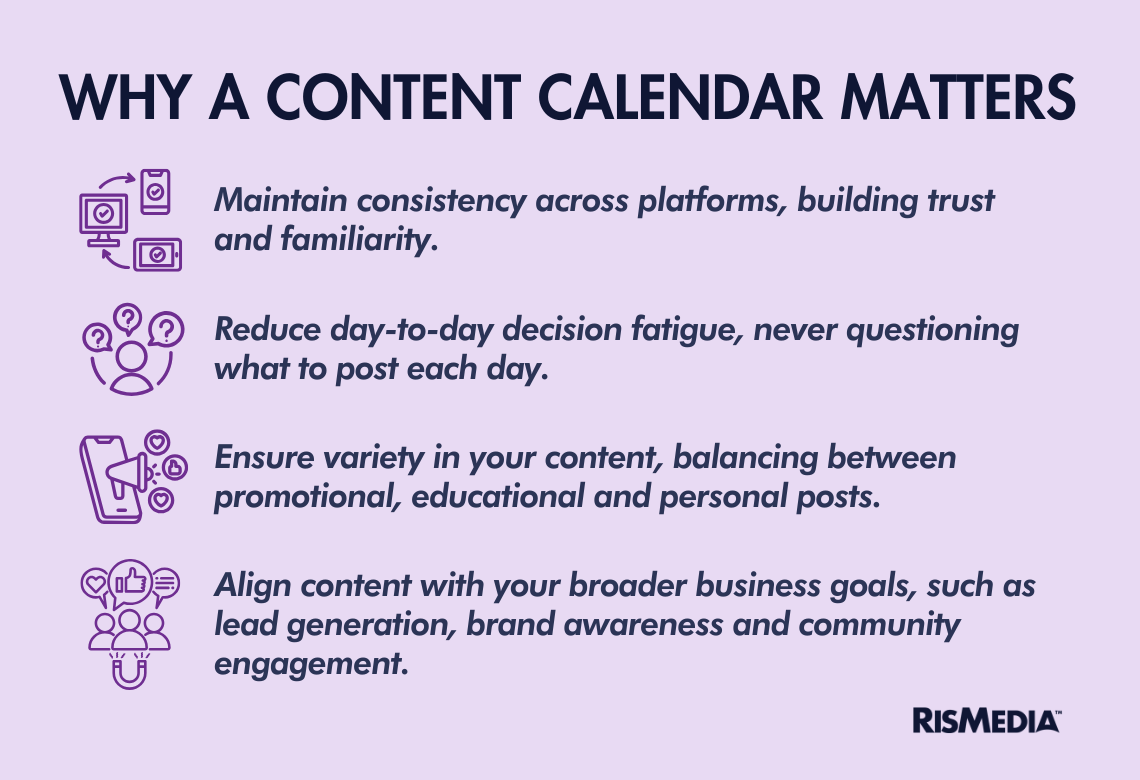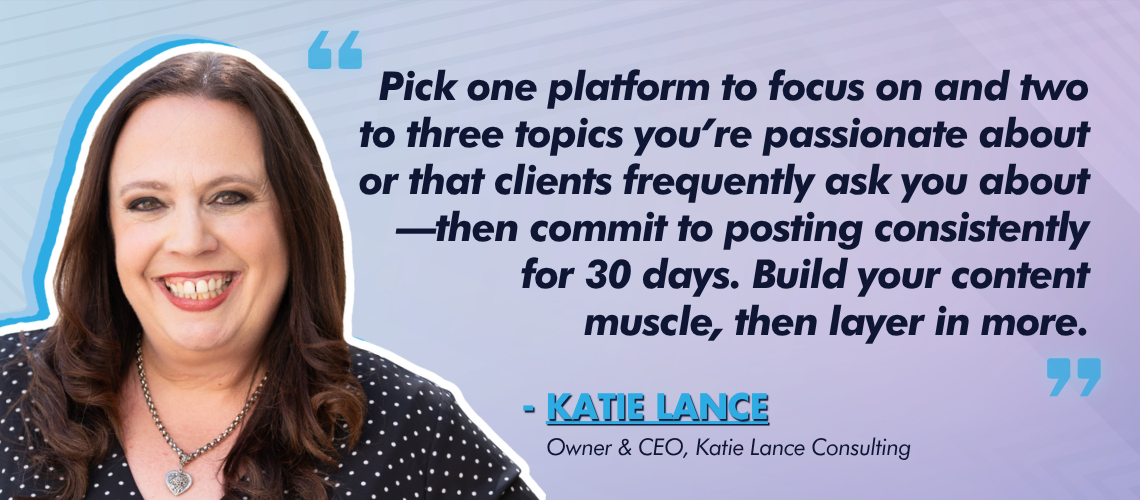Creating content for social media without a plan is like navigating a new city without a map (or GPS). In real estate—where timing, consistency and visibility matter—having structure in your content calendar isn’t just helpful, it’s essential. Planning your posts in advance allows you to stay organized, show up regularly and build a recognizable online presence that supports your long-term business goals.
Why you need a content calendar
For many agents and brokers, social media can quickly become a stressful process. Pressure to post something relevant, creative and timely either daily or multiple times per week, can lead to burnout and inconsistency. A content calendar shifts this dynamic by providing structure and foresight. It turns reactive posting into a proactive strategy.

Planning ahead also ensures that key dates, like local events, market reports or seasonal trends, are integrated into your content and not missed in the moment.
Read: Mastering Social Media Trends to Stay Ahead in Real Estate
CEO and owner of Katie Lance Consulting and social media strategist, Katie Lance explains, “At a high level, I guide agents to focus on one big idea per month that ties into their brand and business goals. This could be a theme like ‘First-Time Homebuyers’ or ‘Local Market Insights.’ From there, we brainstorm four or five core pieces of content that support that monthly theme. This helps take the guesswork out of weekly content and creates built-in consistency across platforms.”
Creating your calendar
When it comes to building your content calendar, start with an end in mind. Ask yourself, “What am I hoping to achieve this month or quarter? Is it more leads? More listings? Increased engagement?” Laying out your goals at the beginning allows you to reverse-engineer the type of content that supports them.
- Step 1: Choose your posting frequency
Posting every single day isn’t always necessary—but consistency is! Whether you choose to post three times per week or six, the key is sticking to a realistic schedule you can sustain. Consistency helps train the algorithm and your audience to expect your content, boosting visibility and trust.
“Start small and go for progress, not perfection,” Lance advises. “Pick one platform to focus on and two to three topics you’re passionate about or that clients frequently ask you about—then commit to posting consistently for 30 days. Build your content muscle, then layer in more.”
- Step 2: Define content categories or themes
Successful social media accounts use themes to guide their content creation. Not only do these themes help keep your posts varied, they also help you organize your thoughts and planning while ensuring that all aspects of your business are being communicated.
Popular themes include:
-
- Market updates and educational tips
- Behind-the-scenes or “day in the life” content
- Client success stories and testimonials
- Listings, open houses and walkthroughs
- Local community spotlights
- Personal anecdotes and agent lifestyle
Choosing four to six recurring content types gives you variety while making weekly planning easier.
Lance recommends using a layered approach. “Think of it like this: Your weekly anchor content is the main event—like a video or blog post. Then, use micro-content like Stories, Reels or email snippets to support and repurpose it. I also advise keeping a few ‘evergreen’ slots open on your calendar to make space for spontaneous or timely posts.”
- Step 3: Add key dates and seasonal opportunities
Once you’ve mapped out how frequently you’ll be posting, don’t forget about key business dates. These can include:
-
- Local and national holidays
- Seasonal real estate trends (e.g., spring seller’s market, back-to-school tips)
- Community events or charity initiatives
- Company milestones, anniversaries or team achievements
- Recurring campaigns like “Testimonial Tuesday” or “FAQ Friday”
Lance suggests quarterly planning to keep content aligned with both seasonal content and your client’s journey.
“In spring, focus on sellers and prepping homes; in fall, pivot to tips for buyers or moving with families,” she says. “Zooming out to plan quarterly allows you to align your content with the market cycle, holidays and personal business goals like open houses or local partnerships.”
Read: Spring Events to Thaw Out Your Lead Generation
Read: Summer Marketing Strategies for Sizzling Success
- Step 4: Balance evergreen and timely content
Lance recommends a 70/30 split when it comes to this balance of content: “70% evergreen, 30% timely. Evergreen content gives your calendar structure. Timely content keeps it fresh.”
-
- Evergreen content: Tips, FAQs, educational videos, testimonials—anything that holds value year-round.
- Timely content: Market shifts, industry news, trends or community updates that keep your profile current and engaging.
Read: Storytelling in Real Estate—Crafting Compelling Narratives for Success
And when the unexpected happens? “I always recommend leaving one to two open content slots each week,” says Lance. “That way, when something important pops up—like a market update or breaking news—you’re not scrambling. You just shift your evergreen post to the following week.”

Tools to support your calendar
Batching content and using the right tools will help you save time and reduce the stress that comes from becoming overwhelmed by your content calendar.
“An agent should take one to two hours a week to plan and create multiple pieces of content at once—especially short-form videos or graphics,” says Lance.
Here are some tools to help streamline the process:
- Planning and scheduling: Later, Planoly, Buffer, Trello or Google Sheets
- Design: Canva, Adobe Express
- Video editing: InShot, CapCut or Canva’s built-in video tools
- Writing support: ChatGPT or other AI tools to help brainstorm captions, hooks or email scripts
Read: Your 15-Minute Fix for Real Estate Content Planning
Planning your content calendar with purpose puts you in control of your digital presence. It can transform your social media from a source of stress into a strategic tool that reflects your business, your brand and your value to clients. By setting clear goals, choosing themes that matter and using the right tools to streamline the process, you’ll not only stay consistent, you’ll start to see results.



